A machine that’s been 10 years in the making is now seeing success, thanks to hydraulic cylinders from Yates Industries.
When Thomas Services La LLC of New Iberia, La. decided to develop a completely new concept and class of machine for oilfield pipe cleaning, they committed to creating a new higher standard for the definition of ‘clean pipe.’ Early on during the conceptual design phase, they determined that hydraulic cylinders were the best solution for many of the operations the machine would complete. “Working with Yates Industries was a very clear decision,” said William Thomas, P.E. of Thomas Services. “Their products are just far superior.”
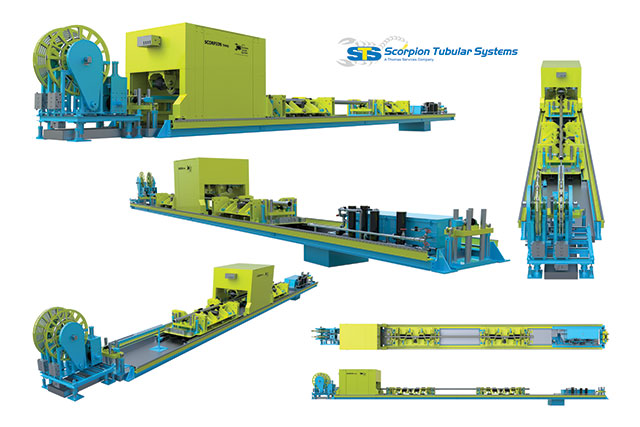
Thomas Services first designed the Scorpion oilfield pipe cleaning system 10 years ago. This image shows Gen I of the design.
The Scorpion Tubular Maintenance System (TMS) cleans the internal and external surfaces of any steel tubulars. The Scorpion defines cleaning to include removal of mud, oils, rust, scale, coatings, liners, cement and other matter from internal and external surface of tubulars. The requirement to clean tubulars is a fundamental step in the process of maintaining, inspecting, prepping, and/or salvaging tubulars for a variety of needs in the oil and gas industry.
The Scorpion TMS’ patented designs are based around versatility and capability. It allows users to accommodate any type of tubulars covering outer diameter size ranges of 1 to 48 in. OD and tubular lengths per user specifications ranging anywhere from 1 to 100 ft long. It also allows users to choose from an array of cleaning techniques, processes, and cleaning media methods including high volume water blasting and jetting at variable pressures typically ranging from 3,000 to 20,000 psi, with the option to increase pressure ratings across the system for ultra-high pressure (40,000 psi) water blasting for special applications requiring extreme pressures.
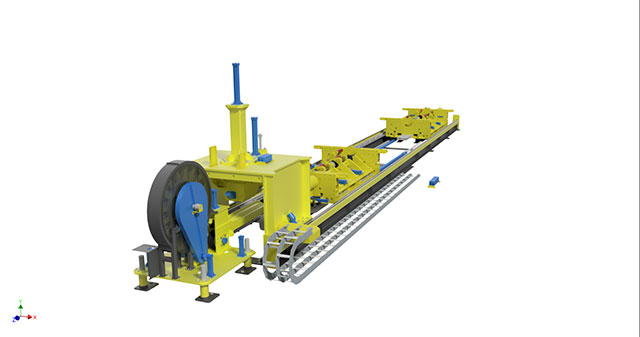
Thomas Services Gen II Scorpion oilfield pipe cleaning system
The Scorpion TMS also includes a patented and powerful hydraulic powered wire wheel brusher with an automated and mechanical floating feature for brushing external surface of tubulars. Air-powered cleaning devices can also be used with the Scorpion IDS cleaning system instead of water powered devices if preferred. “The Scorpion TMS is a state-of-the-art pipe cleaning machine with revolutionary patented technology, which allows it to redefine pipe cleaning,” Thomas said.
The Scorpion was developed to effectively, efficiently and safely handle any condition of Scorpion TMS (Gen. II) tubulars that may arise.
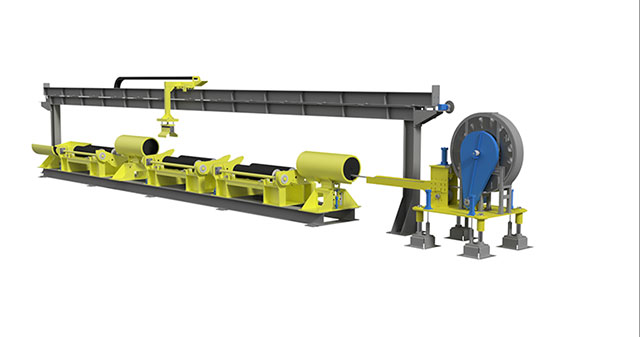
The Scorpion Gen III was recently commissioned for use by NOV Wellbore Technologies – Tuboscope-West Texas Div., for its state of the art new Tuboscope pipe inspection facility located in Odessa, Texas.
Other pipe cleaning systems are limited. The Scorpion TMS is engineered to transfer user desired minimum or maximum amount of cleaning power to the tubular with attention to fluid mechanics, horsepower, and precision controls. The Scorpion maintains a minimal footprint, about 50% shorter than other systems thanks to its ID cleaning system and compact OD cleaning system. Enhanced with its pipe rotation system, the Scorpion TMS cleans the internal and external of each stationary and/or spinning tubular with lateral flow of tubulars incoming to and outgoing from the system.
Pipe cleaning machines are used in the oil and gas industry for systematic maintenance of valuable tubular assets such as drill pipe and work string tubulars. Clean drilling and exploration tubulars are imperative to maintain healthy assets. Such tubulars are expensive and often used in critical, high-profile applications. They are exposed to some of the most extreme stresses and harshest elements and environments. These tubulars are used for drilling and prducing oil and gas wells, then returned for cleaning, careful inspection for damages, and re-prepped for continued use. Other tubulars may be for pipelines in which the tubular may have coatings that need to be stripped and base steel prepared for use. Some applications also need to decommission old tubulars and remove contamination prior to recycling or disposing.
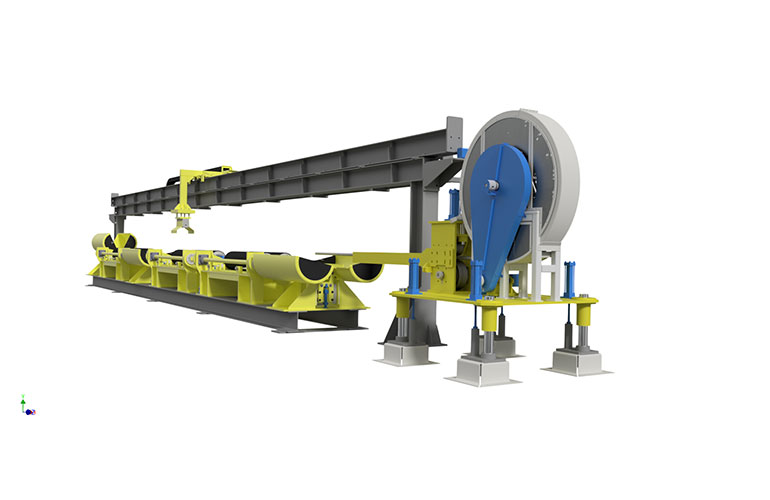
Another look at the Gen III Scorpion pipe cleaning system from Thomas Services
The machines rely heavily on hydraulic cylinders from Yates. “Yates cylinders are superior in quality. They are manufactured with precision and constructed for durability. Yates also maintains a very user friendly and useful website, which allows users to custom specify and quickly obtain reliably accurate CAD models and drawings of any user-customized cylinders. This is a valuable tool during the design modeling and throughout the procurement process,” Thomas said. “Yates’ support and service go well with their product. You have access to expertise needed and service that you know is the best in the industry for hydraulic cylinders.”
Within the Scorpion TMS, hydraulic cylinders are used to laterally load incoming dirty tubulars into the system and laterally unload the cleaned tubular out of the system usually in a production type of scale with hundreds even thousands of tubulars for certain jobs.
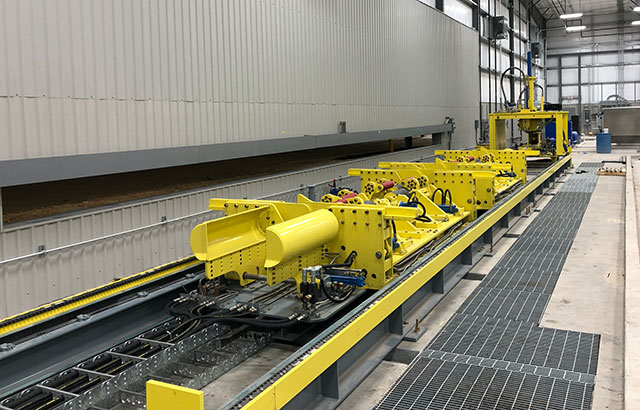
Here and below: Photos of NOV Tuboscope’s Scorpion TMS, taken during installation at
Tuboscope’s West Texas Facility located in Odessa, Texas, prior to completion of their facility and completion of Scorpion installation.
The hydraulic cylinders are also used to actuate muffler devices, which enclose the ends of the tubulars to contain noise and flying debris during the internal/ID cleaning process. Hydraulic cylinders are also used to precisely position the Scorpion machinery per job or application needs, as tubulars may have a variety of geometry features to accommodate.
The Scorpion PRS (Pipe Rotation System) is hydraulically adjusted via hydraulic cylinders. These rollers allow for stable support of tubular as needed. Support is requires while spinning of the stationary tubular is done, often at remarkably high pipe spin speeds, from less than 1 to 1,000 rpm. This is done for cleaning the outer surface and sometimes during internal cleaning as well.
When needed for bent pipe, the Scorpion TMS’ pipe clamp rollers use Yates’ hydraulic cylinders to apply clamp rollers at user-specified pressure and force onto the pipe during cleaning in order to hydraulically straighten bent pipe during spinning. This ensures smooth cleaning and is also used as needed to prevent axial walking of the tubular during some ID and some OD cleaning work. The positioning of the ID, OD, and PRS machinery for a certain job is set via hydraulic cylinders in general. “This adjustability allows for precise, dominant and stable control of tubulars enabling Scorpion machinery to maximize effectiveness and consistency of cleaning results,” Thomas said.
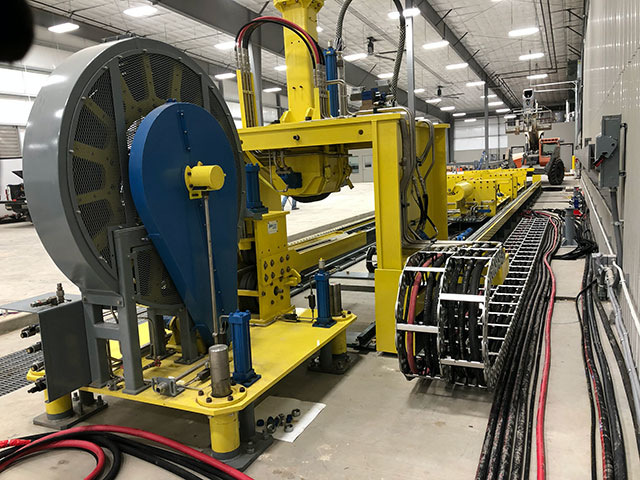 The system performs so well, that a major company in the industry — NOV Wellbore Technologies – Tuboscope-West Texas Div., recently purchased and commissioned into service a new Scorpion TMS at its state of the art new Tuboscope pipe inspection facility located in Odessa, Texas. The Tuboscope Scorpion TMS (Gen II) is refined and more sophisticated than its predecessor prototype in New Iberia. This second-generation Scorpion TMS is a cleaner, more compact, and safer system overall.
The system performs so well, that a major company in the industry — NOV Wellbore Technologies – Tuboscope-West Texas Div., recently purchased and commissioned into service a new Scorpion TMS at its state of the art new Tuboscope pipe inspection facility located in Odessa, Texas. The Tuboscope Scorpion TMS (Gen II) is refined and more sophisticated than its predecessor prototype in New Iberia. This second-generation Scorpion TMS is a cleaner, more compact, and safer system overall.
With its significant design improvements, advanced controls and proven features incorporated througout, NOV Tuboscope’s Scorpion TMS has proven itself to be a superior new class of pipe cleaning systems and has surpassed expectations as expected, Thomas said.
The NOV-Tuboscope West Texas facility is a state-of-the-art facility for cleaning, inspection, machining, and processing tubulars for the oil and gas industry. Their West Texas Facility and Scorpion TMS, gives NOV-Tuboscope unmatched superior pipe cleaning and service capabilities.
“The Scorpion is a superior cleaning system, that fit really well with the high level of automation and quality of equipment that we installed in this facility. Our goal was to make this a ‘Flagship’ Inspection and Machining location. A lot of thought, design, and engineering went into the layout, components, work flow, ‘hands off” pipe movement, and overall quality and longevity of the machinery installed. This is truly an amazing facility,” said
Jerry Hansen, Div. Operations Manager, Fabrication & New Equipment, NOV Tuboscope.
Thomas Services La LLC
thomasservices.org
Yates Industries
yatesind.com
NOV-Tuboscope
www.nov.com
Filed Under: Cylinders & Actuators